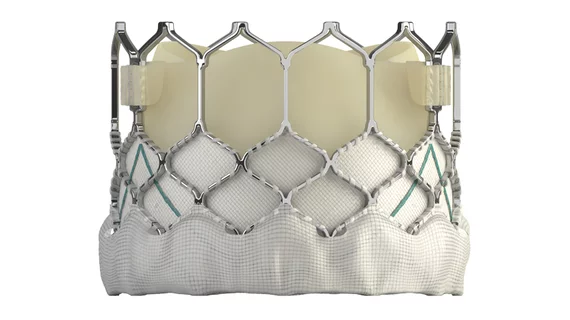A new analysis published in the Journal of the American College of Cardiology suggests the learning curve for achieving the best transcatheter aortic valve replacement (TAVR) outcomes may have dissipated with a current-generation, balloon-expandable device.
Lead author Mark J. Russo, MD, MS, and colleagues used the Transcatheter Valve Therapy (TVT) registry to study nearly 62,000 TAVR procedures performed with Edwards Lifesciences’ balloon-expandable Sapien valves from November 2011 through January 2017.
They assessed 30-day outcomes including all-cause mortality, stroke and major vascular complications, and conducted analyses to determine whether individual facilities had a learning curve of a certain number of cases or a relationship between their procedural volume and outcomes. The volume-outcome relationship (VOR) was assessed by breaking hospitals down into how many balloon-expandable TAVR valves they implanted per month.
When all three generations of Sapien valves were considered, Russo et al. reported a learning curve of 200 TAVR procedures for a given center. A “steep” learning curve was present for about the first 55 cases, with a much more gradual improvement in outcomes after that early experience out to the 200th procedure. Beyond that, there was no further learning curve or relationship between outcomes and volume of TAVRs, the authors noted.
But when restricting the analysis to only the 28,227 TAVRs performed with the newest valve, the Sapien 3, Russo et al. found no evidence of a learning curve or a VOR. They acknowledged centers’ experience with the previous-generation valves may have confounded their results, but also found that centers without previous balloon-expandable (BE) valve experience didn’t show a significant volume-outcome relationship—although there was a trend toward more vascular complications at centers that performed two or fewer Sapien 3 implants per month.
“With refinements of procedural techniques and diffusion of best practices, extensive knowledge sharing, rigorous proctoring, ongoing case support, and the heart team approach, as well as improvements in device technology, excellent outcomes with BE valves should be expected even early in a center’s experience and are sustainable regardless of the center’s case volume,” Russo and co-authors wrote.
These findings are important in light of the ongoing debate over how best to balance TAVR quality and access. CMS is set to release a new national coverage determination (NCD) for TAVR in June, when the agency will determine the presence and extent of procedural volume thresholds for centers to start and maintain a TAVR program.
The current NCD requires centers to perform at least 20 TAVRs annually—or 40 in a two-year span—to maintain an existing program, but a consensus document from several cardiology societies recommended the new NCD bump those minimums up to 50 per year or 100 over two years.
Russo et al. said later adopters of the transcatheter procedure likely benefited from other facilities and clinicians sharing best practices, as well as device improvements that limited paravalvular leak and facilitated a greater proportion of procedures using a transfemoral approach and/or conscious sedation rather than general anesthesia.
“Although not captured in the available dataset, other widely adopted changes in practice that occurred over this time included the use of multidimensional CT imaging for assessing aortic root anatomy, decreased frequency of pre-dilation, and decreased frequency of post-dilation,” the authors wrote. “Concurrently … the risk profile of the TAVR patients changed dramatically; nearly three-fourths of the SAPIEN cases were in extreme-risk patients compared with less than one-fifth of the (Sapien 3) cases. In aggregate, these advances in technology along with changes in practice and risk profile have been associated with measurable improvements in patient outcomes.”
Russo and colleagues noted more work is needed to identify and apply the processes of care in top-performing, low-volume centers to other facilities.
In a related editorial, University of Pennsylvania cardiologists Saif Anwaruddin, MD, and Matthew D. Saybolt, MD, said it might be time to consider a metric other than mortality to assess TAVR quality, given the very low 30-day death rates as the procedure becomes more refined and offered to healthier patients.
“As mortality in TAVR becomes more of a quotable risk than an actual event, particularly in lower-risk cohorts, we need composite outcome metrics that include clinical events as well as real measures of procedural quality, those reflecting the total value of care involved in ensuring a good outcome for the patient,” they wrote. “Whether they are related to programmatic volume remains to be seen.”
Anwaruddin and Saybolt wrote that Russo et al.’s findings raise the important question of whether a learning curve and VOR remain with the latest-generation TAVR valves at less-experienced centers.
“However, like most things in our world, the truth is somewhere in the middle, and it would seem unlikely that a VOR is completely absent even for latest-generation TAVR,” the editorialists wrote. “What remains apparent is that work needs to be done to better assess and to improve upon quality and outcomes in TAVR across all sites in the best interest of our patients.”
Edwards Lifesciences conducted the statistical analyses for Russo and colleagues’ study and has financial relationships with several of the authors.

